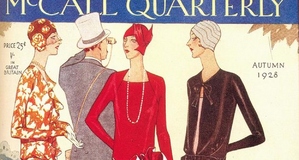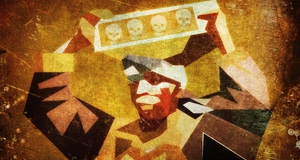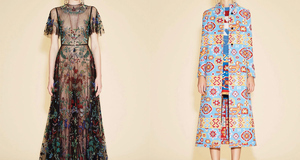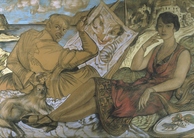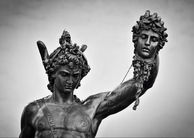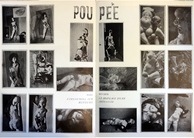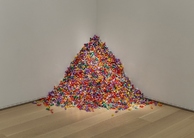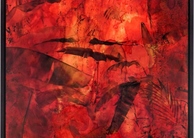Terry Richardson and the Celebration of "Porn Chic:" A Critique of Fashion Photography
By
2020, Vol. 12 No. 09 | pg. 1/1
IN THIS ARTICLE
KEYWORDS
In On Photography, Susan Sontag derides photography for generating a sense of false objectivity. Focusing on the moral implications of taking a photograph, she explores the relationship between artist and subject, exposing photography as a medium contingent upon violating its subjects.[1] Engaging with Sontag’s text, the following analysis studies fashion photography as a site embodying this exploitation, revealing the disturbing power dynamic between a defamed fashion photographer and his underage subject. In deconstructing Terry Richardson’s 2011 image of Lindsey Wixson (fig 1), I hope to raise ethical concerns about Richardson’s work. Leaning first on a formalist approach, I uncover the signifiers that index Wixson’s objectification. Next, I transition into a feminist reading of the image, drawing on Merksin’s critique of fashion advertisements. Gauging on what she calls the “pornographication of the American girl,”[2] I uncover how Richardson’s hyper-fetishization of Wixson exhibits a form of discursive violence often subdued by the glamor and aestheticism attributed to his work. Despite controversial claims regarding Richardson’s sexual misconduct on sets, the fashion world has championed these images for decades, permitting and re-producing the exploitation of young girls for consumerist gain. Richardson Presents: Porn ChicIn 2017, various high profile newspapers reported that Vogue and Condé Nast were joining the list of companies severing ties with American photographer Terry Richardson. According to Charles Teather, “Some of the world’s biggest magazines will no longer commission [Richardson’s] work as claims of sexual harassment and abuse resurface.”3 While Richardson’s behavior gained increased attention during the #MeToo movement, models were making allegations against the photographer beginning in 2001, indicating over a decade in which Richardson knowingly victimized models and actresses without consequences. Jamie Peck describes her encounter with Richardson in a New York Post article, exposing his bizarre and graphic requests. She recounts, “He asked me to take my tampon out for him to play with” and later reveals he coerced her into stimulating him as an assistant watched.4 In response to the allegations, Richardson has declared that all interactions were consensual despite opposing claims from the accusers.5 The notion of consent resonates strongly with the ethics of photography. Both Linfield and Sontag have explored how a victim’s ability to provide consent shifts the moral implications of both the viewer and the photographer. The subject of my analysis, Richardson’s photograph of Lindsey Wixson, hails us to revisit consent’s definition and significance in debating the ethics of a photograph. At the time of the image in question, Wixson was 17 years old, bellow the age of legal consent in North America. While Wixson has not come forward with any accusations against Richardson, the evidence of discursive violence in his depiction of her suggests not only the visual and sexual exploitation of a woman, but the fetishization of a minor through pornographic elements. According to Fuchs, “Pornography refers to any literature or film (or other art technological form) that describes or depicts sexual organs, preludes to sexual activity (or related organs and activities) in such a way as to produce sexual arousal in the user or viewer.”6 As I will reveal in my visual analysis, the allusions to oral sex in Richardson’s image of Wixson allow us to read the image as pornographic. Furthermore, Richardson openly reveals pornography as a source of inspiration. In an interview with Richard Benson, Richardson states, “We all have our own internal porn star, and technology has allowed it to develop… that genuine, raw sexuality is breaking the veneer of polite behavior all the time. I try to capture those moments.”7 If Richardson is attempting to “capture these [pornographic] moments,” he is inherently self-fashioning as a pornographer and labelling his subjects as porn stars. In this case, the image of Lindsey Wixson is none other than an instance of child pornography disguised as art by the glitz of the fashion world. As Benson eloquently puts, “Terry Richardson created porn ‘chic’ and moulded the look of an era… the photographer… shaped an aesthetic of exploitation.”8 The next portion of my essay deconstructs Richardson’s image of Wixson for a 2011 magazine spread, exposing his perversions and use of discursive violence to form an aesthetic informed by the victimization of young women. Lindsey Wixson: the Sexy Little Girl Next DoorIn a 2011 i-D Magazine shoot, Terry Richardson renders a 17 year old gap-toothed model in a black and blue blazer with red lipstick and matching nail polish. She winks at us through a stained face as she runs her tongue up a chocolate ice cream cone. The image frame fragments her body, keeping her legs from our view. Her one piercing green eye returns our gaze as her disheveled brown hair frames her face. There is a blank background, ensuring we direct our attention to Wixson. The paradox between child and woman in the image is startling. The ice cream cone exists in the photograph as both a signifier for childhood pleasure and a fallic object she engages with her mouth. Her oversized jacket dwarfs her slender frame, rendering her chest as flat and pre-pubescent. The gap in her tooth is reminiscent of a little girl in need of braces. Nevertheless, she gazes at us with a knowing sensuality, implicating us as we watch her. Richardson positions us as the photographer. Wixson, looking wild and uncontainable, engages us as she had Richardson.In an essay exploring the “obscene body,” Elinor Fuchs describes how female artists in the 1980s would self-fashion themselves as spectacles. She writes, “The sacred body has been replaced by the obscene body- aggressive, scatological, and sometimes pornographic.”9 Wixson does embody Fuchs’s description, yet as a model, she lacks agency in her performance. Wixson does not self-fashion as pornographic- Richardson has designated her a spectacle and object for erotic consumption. In this case, we have a power imbalance between the photographer and the model as he claims the right to manipulate her body and circulate its image. Sontag draws on the eroticization of the subject by mapping photographers’ perversions. She writes, “If professional photographers often have sexual fantasies when they are behind the camera, perhaps the perversion lives in the fact that these fantasies are both plausible and so inappropriate.”10 Richardson’s photograph of Wixson exemplifies this juxtaposition. The fantasy’s feasibility stems from their power dynamic: Wixson is subject to Richardson. As Merskin suggests, Richardson as a photographer performs “rituals of subordination” wherein he situates himself in a position of dominance. Merskin writes, “A man standing over a woman, standing behind her or in the shadows, or even as the implied viewer represents power and control.”11 Additionally, Richardson broadcasts her image, publishing her face within the fashion world. He has access to and power over her body as he photographs her, but also, as a celebrated photographer, has control over her relevance in the fashion industry. The unethical, “inappropriate” aspect Sontag discusses derives in this image from their age difference and Wixson’s status as a minor, but moreover, in Richardson’s exploitation of her. Sontag reveals, “There is something predatory in the act of taking a picture. To photograph people is to violate them, by seeing them as they never see themselves, by having knowledge of them they can never have; it turns people into objects that can be symbolically possessed.”12 Sontag’s assertion applies to Richardson as he fashions Wixson into an erotic object for pleasure and consumption. The symbolic possession Sontag pinpoints emerges when other individuals, primarily men, engage with this fetishized image of Wixson without her knowledge or consent. Ultimately, her image is no longer her own. Scholars may critique my argument by suggesting that her agreement to pose for Richardson signifies her consent. In response to that logic, I call upon the evidence of discursive violence. By signing a contract, Wixson agreed to model for Richardson. However, the nature of how he captures her is layered and complex. Identifying the signifiers of discursive violence takes unpacking. Therefore, Wixson may be unaware of her exploitation. As discussed by McLaren, Leonardo, and Allen, “Discursive violence frequently escapes critical scrutiny because of its less than immediate effects and the ways that it symbolically inscribes subjectivities.”13 In other words, the evidence of discursive violence is abstract and therefore difficult to definitively prove. The next portion of my analysis focuses on deciphering discursive violence and exploring its effect on the subject’s image. The Hidden Domination of Lindsey WixsonIn his discussion with Maureen Callahan in 2013, Richardson reveals, “I was a shy kid… and now I’m this powerful guy with a boner, dominating all these girls.”14 Through discursive violence, Richardson asserts his dominance over his subjects. In the photograph of Wixson, there are three main signifiers of discursive violence. First, Richardson traps her within the frame. He has removed her legs from the image, robbing her of her mobility. Next, he stages Wixson with a smear of chocolate ice cream on her eye. While her wink suggests flirtation, we can also read her eye as swollen shut. The ice cream likens a bloody bruise. If we consider this possibility, Richardson has taken away a part of her vision. In this photograph, she views her voyeur with one eye closed, hindering her ability to properly visualize her exploiter. We may read this as a form of symbolic protection, obscuring the identity of her spectator. On the other hand, a black-eye implicates Richardson as an aggressor. We know he is in the room with her, so perhaps he credits himself with an index of violence. Finally, Richardson positions the ice cream cone at her mouth. The fallice draws on Wixson performing oral sex. If we engage with the image deeper, however, the fallice is pressing against her tongue, preventing her from speaking. Richardson has therefore taken her ability to communicate, reducing her to to this voiceless, symbolically-battered beauty. The photograph is uncannily similar to a hard-core porn image. According to Stankiewicz and Roselli, “The sexual victimization of women that was once limited to pornography has found expression not only in films and television shows, but in advertising as well. The body positions, facial expressions, and sexual power relationships between men and women that occur in advertising have often been adopted from violent pornography.”15 In this image, Wixson is a victim of Richardson’s discursive violence, and the circulation of this image within the fashion world only glorifies and aestheticizes the dynamic. Stankiewicz and Roselli expand on their argument by suggesting the effects of these images. They write, “The simultaneous presentation of women as sexualized and distressed reinforces the association between women’s sexuality and the experience of physical and emotional pain. Therefore, such images may function to normalize violence against women.”16 While I agree that photographs like Richardson’s do regularize the exploitation of the female body, I believe fashion photography specifically has an even stronger influence. In the final section of my essay, I will explore the consequences of these photographs. Expanding on Stankiewicz and Roselli’s statements, I will implicate the fashion world as well. While Richardson utilizes Wixson’s body for his own perversions, the fashion industry too capitalizes on her exploitation. Lasting EffectsIn “The Stimulated (fictitious) Body,” Lucia Ruggerone reveals, “As has been shown mostly by psychological studies, [fashion photographs] become, at least for women, an important reference point for the construction of their own image and for their conceptions of their selves.”17 Fashion photography does not simply sell clothes, but body types, personas, and beauty standards. If the fashion world is circulating images that inflict discursive violence on women, it is condoning and even encouraging women to model themselves after these suppressed and objectified subjects. In the case of Lindsey Wixson’s photograph, Richardson suggests women strive for submission. I implore you to critique the ethics not only of Richardson’s photograph, but of the entire industry of fashion photography - an industry that permitted a sexual predator to bypass morals of non-violence and gender equality. As Merskin argues, “By constructing what is sexy, fashion advertising works to reinforce gender differences and see roles to perpetuate an ideology of the naturalness of female submission and male dominance.”18 In blunt terms, Richardson is glorifying the archetype of a submissive 17-year old porn star by exploiting a young, unassuming model. By disregarding the claims of sexual misconduct against Richardson, the fashion world inherently silences his victims and publishes this “pornographied American girl” as an ideal. As a scholar and critique of fashion photography, I can only hope that drawing attention to discursive violence in these images helps expose their unethical intentions and perverse methodology. ReferencesBenson, R. (2017, October 29). How Terry Richardson created porn ‘chic’ and moulded the look of an era. The Guardian. Callahan, M. (2013, November 3). Exposing Terry Richardson, fashion’s favorite ‘pervert’. The New York Post. Eleftheriou-Smith, L. (2017, October 25). Terry Richardson: Photographer accused of sexual abuse claims all sexual shoots were consensual. The Independent. Fuchs, E. (2010). The death of character: Perspectives on theater after modernism. Bloomington: Indiana Univ. Press. Linfield, S. (2012). The cruel radiance: Photography and political violence. University of Chicago Press. McLaren, P., Leonardo, Z., & Allen, R. (1999). The Gift of Si(gh)ted Violence: Toward a Discursive Intervention into the Organization of Capitalism.Discourse,21(2), 139-162. Retrieved from http://www.jstor.org/stable/41389537 Merskin, D. (2006). Where are the Clothes? The Pornographic Gaze in Mainstream American Fashion Advertising (J. Lambiase, Ed.). In T. Reichart (Ed.), Sex in consumer culture : The erotic content of media and marketing (pp. 199-212). Erlbaum Associates. Ruggerone, L. (2006, December). The simulated (fictitious) body: The production of women's images in fashion photography. Poetics, 34(6), 354-369. doi:https://doi.org/10.1016/j.poetic.2006.10.005 Sontag, S. (1978). Susan Sontag on photography. Allen Lane. Retrieved from http://www.lab404.com/3741/readings/sontag.pdf Stankiewicz, J., & Roselli, F. (2008, January 15). Women as Sex Objects and Victims in Print Advertisements. Sex Roles, 48, 579-589. doi:10.1007/s11199-007-9359-1 Teather, C. (2017, October 24). Terry Richardson's verdict on Vogue decision to ban his work: 'Disappointing'. The Evening Standard. 1.) Sontag, 1978, p.10. 2.) Merskin, 2016, p.133. 3.) Teather, 2017. 4.) Callahan, 2013. 5.) Eleftheriou-Smith, 2017. 6.) Fuchs, 1996, p.33. 7.) Benson, 2017. 8.) Benson, 2017. 9.) Fuchs, ,1996, p.33. 10.) Sontag, 1978, p.9. 11.) Merskin, 2006, p.206. 12.) Sontag, 1978, p.10. 13.) McLaren, Leonardo, & Allen, 1999, p.140. 14.) Callahan, 2013. 15.) Stankiewicz & Roselli, 2008, p.581. 16.) Stankiewicz and Roselli, 2008, p.585. 17.) Ruggerone, 2006, p.354. 18.) Merskin, 2006, p.204. Suggested Reading from Inquiries Journal
Inquiries Journal provides undergraduate and graduate students around the world a platform for the wide dissemination of academic work over a range of core disciplines. Representing the work of students from hundreds of institutions around the globe, Inquiries Journal's large database of academic articles is completely free. Learn more | Blog | Submit Latest in Visual Arts |







